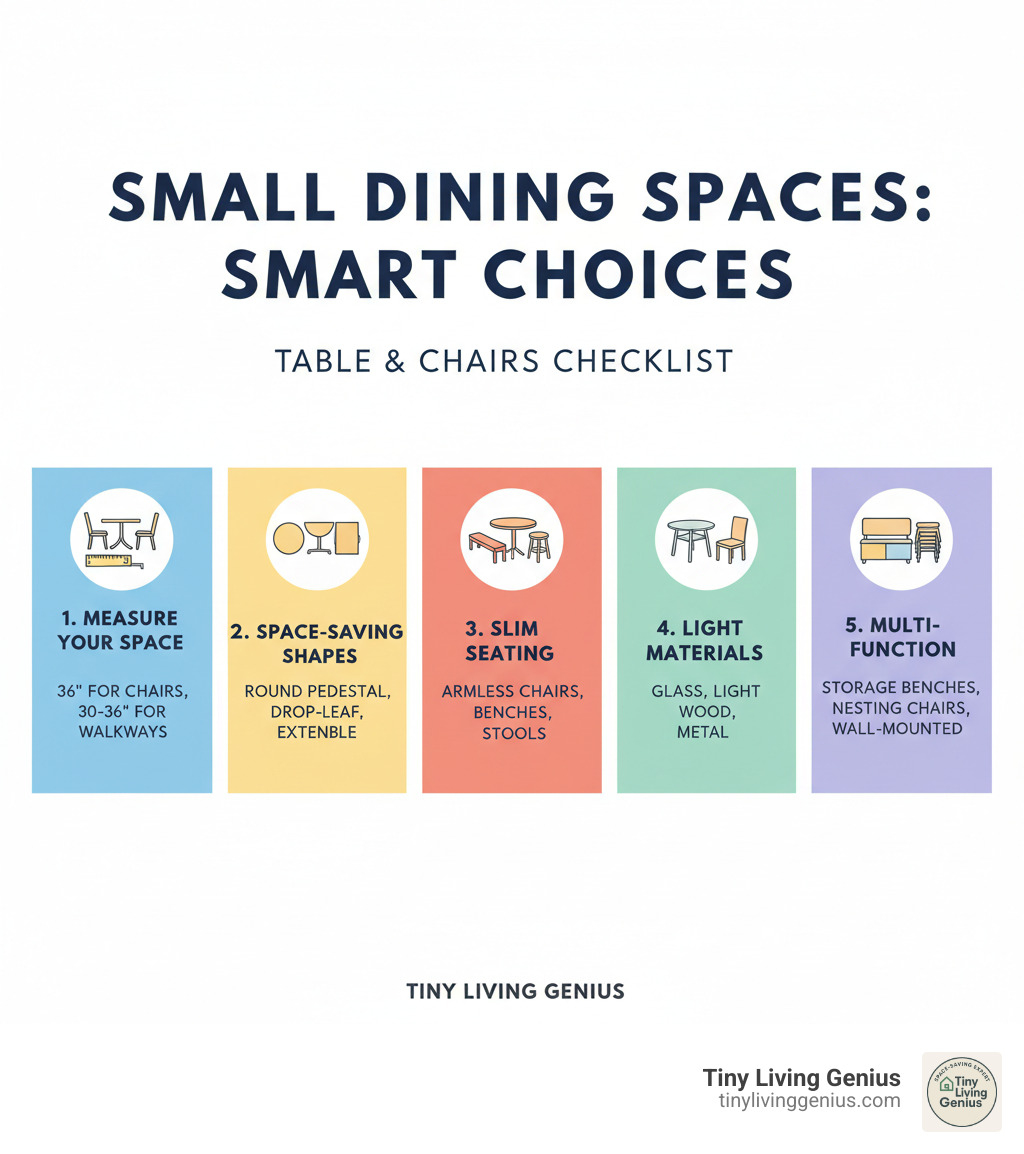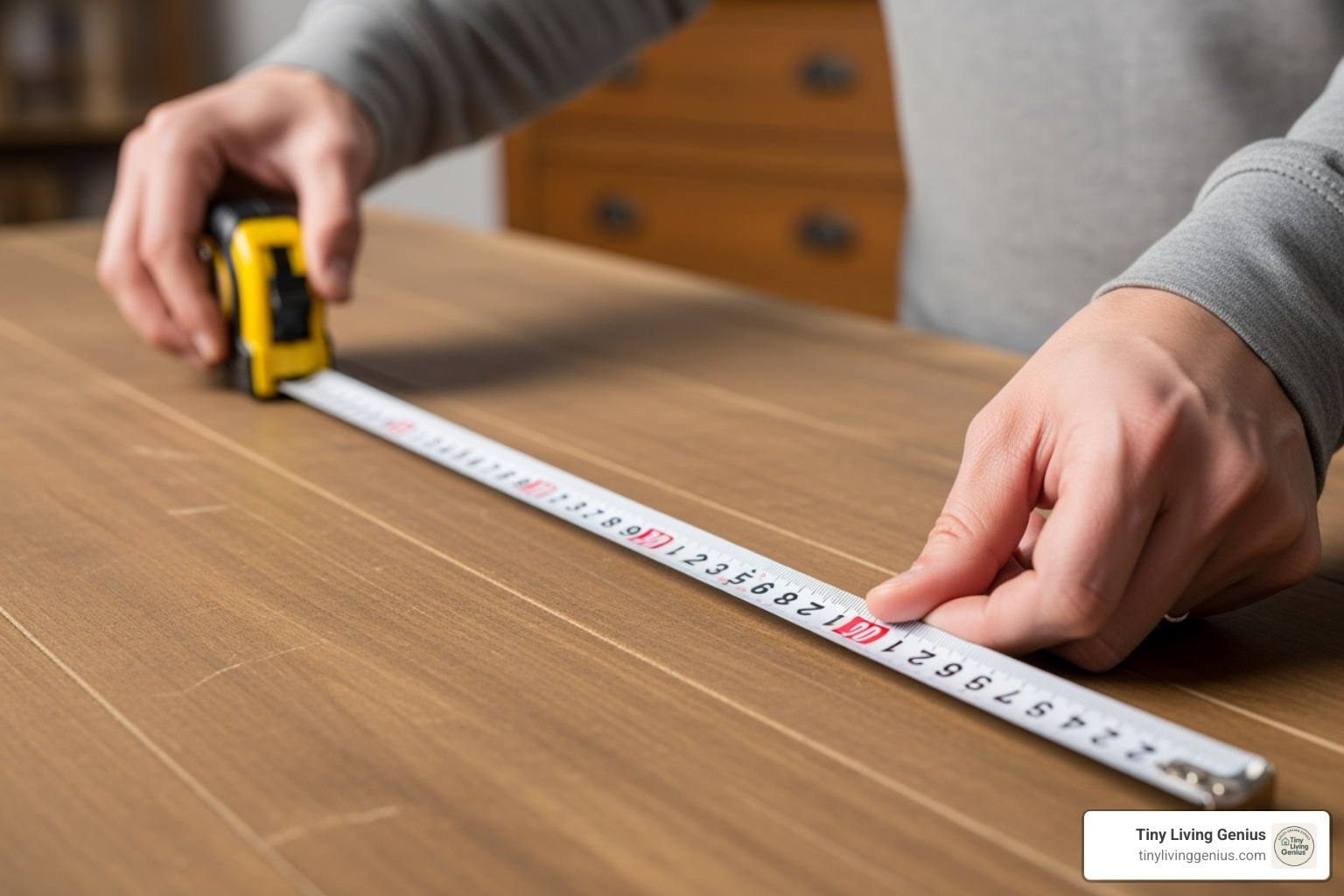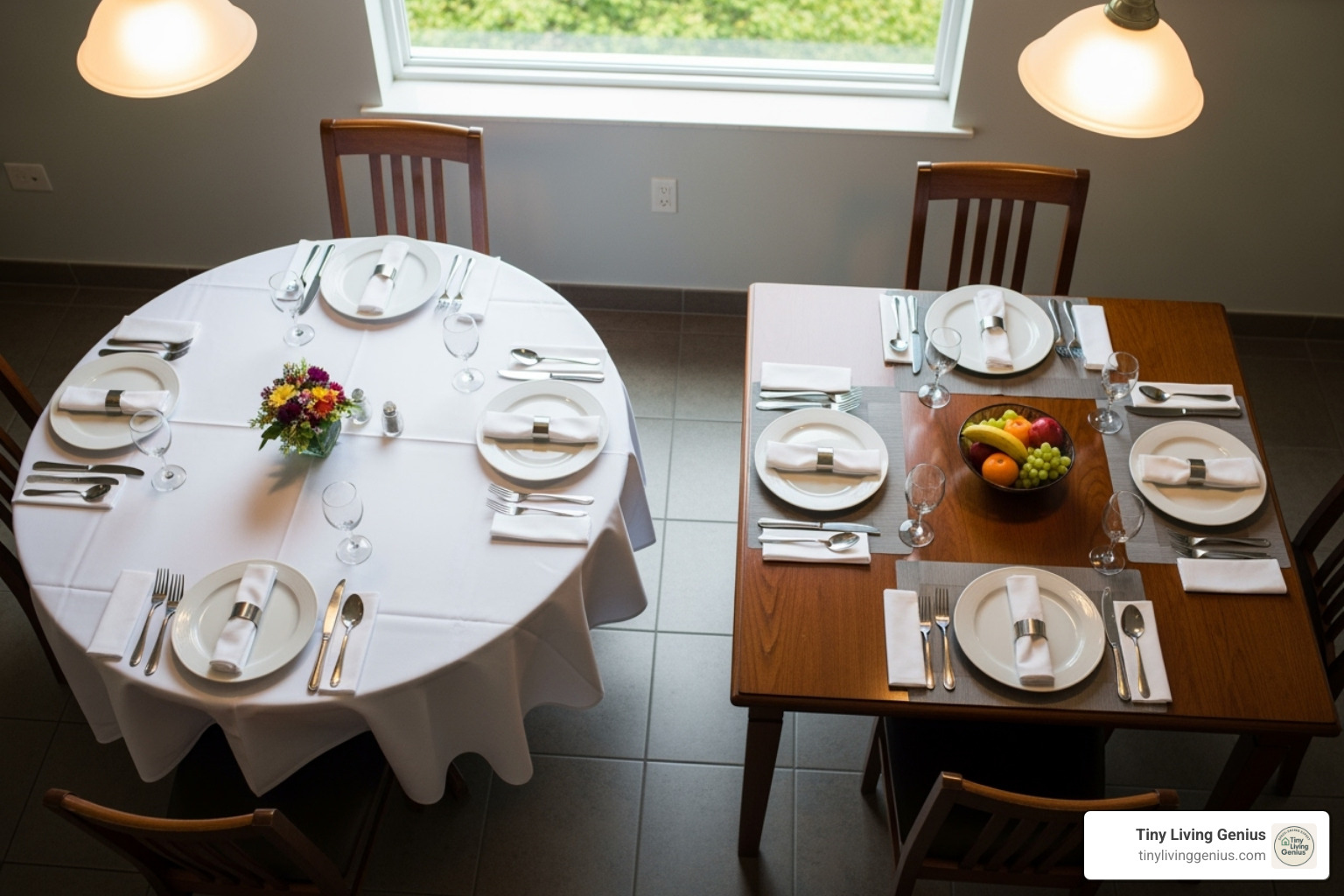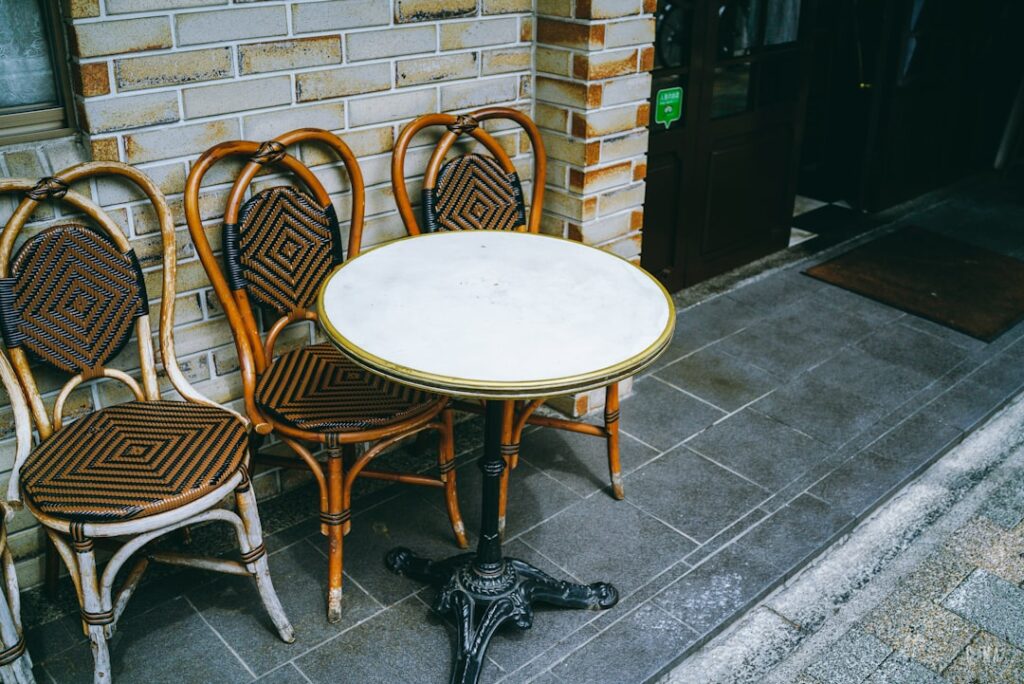Table and chairs for small dining room: Ultimate 2025
Why the Right Table and Chairs Transform Your Small Dining Room
Finding the perfect table and chairs for small dining room spaces can feel overwhelming, but the right choice makes all the difference. Here’s what you need to know:
Quick Answer: Best Options for Small Dining Rooms
| Solution Type | Best For | Key Benefit |
|---|---|---|
| Round Pedestal Tables | Tight spaces, awkward corners | No sharp edges, better flow |
| Drop-Leaf Tables | Flexible seating needs | Expands when needed, folds down daily |
| Bistro Sets (2-person) | Studio apartments, breakfast nooks | Minimal footprint |
| Benches + Table | Wall placement, families | Seats more people, tucks completely under |
| Extendable Sets | Occasional entertaining | Daily compact size, expands for guests |
In a small apartment, every piece of furniture must be functional. The demand for table and chairs for small dining room setups has surged as more people accept compact living. The right dining set saves space, creates a dedicated meal zone, improves traffic flow, and makes your home feel less cluttered.
The challenge is finding a table that fits your lifestyle and seating needs without cramping your space. Common mistakes include choosing furniture that’s too large or dark, which shrinks a room visually. It’s also crucial to account for clearance space (at least 36 inches to pull out a chair) and consider multi-functional options like storage benches.
I’m Ramy Saber, founder of Tiny Living Genius. My background in civil engineering and facility operations has shown me how critical smart space planning is. I’ve spent years helping people find the perfect table and chairs for small dining room setups that maximize function and style.

Table and chairs for small dining room terms at a glance:
- dining room tables for narrow spaces
- dining tables circular
- small kitchen table for small kitchen
Why Choose a Compact Dining Set?
When working with limited square footage, every piece of furniture needs to justify its existence. A table and chairs for small dining room setup isn’t just about fitting into a tight corner; it’s about changing how your entire space functions and feels.
The Space You Didn’t Know You Had
A properly sized compact dining set frees up valuable floor space, making your room feel bigger. This creates improved traffic flow, so you’re no longer shuffling sideways between the table and the wall. It’s real, usable square footage.
One Piece, Multiple Jobs
Compact dining sets excel at multi-functionality. Many small tables double as workspaces, homework stations, or game tables. Some even transform from console tables into full dining surfaces. This versatility is essential for small-space living. For more inspiration, check out our guide on Creative Ideas for Small Space Furniture: Maximizing Functionality Small Space.
Creating Order in Open Spaces
In a studio or open-plan apartment, a compact dining set establishes a dedicated dining zone. This simple act creates a sense of routine and helps you avoid clutter by giving dining essentials a proper home, rather than letting them spread across countertops and coffee tables.
Looking Good While Doing Good
Finally, a dining set that’s proportional to your room has immense visual appeal. When furniture matches the scale of your space, everything feels harmonious and thoughtfully designed. A small dining room with an appropriately sized table and chairs for small dining room setup looks curated and intentional, not cramped. The right set creates balance through proportional design, using features like rounded edges, glass tops, or slim profiles to improve the feeling of space.
Finding the Perfect Fit: Types of Table and Chairs for Small Dining Room
Finding the right table and chairs for small dining room spaces is about understanding your space and knowing what works. Before falling in love with a set online, we need to do some homework to avoid ending up with a table that doesn’t fit or leaves no room to use it.

Success starts with measuring. This step will save you from heartache and return shipping fees. For a deeper dive, our How to Choose the Right Furniture for Your Small Space: A Comprehensive Guide is packed with tips.
How to Measure Your Space Correctly
First, measure your room’s dimensions. Then, calculate the usable space for your dining area. The table footprint is just the start. The golden rule: you need at least 36 inches from the table’s edge to any wall or furniture for chair pull-out space. For walkway clearance, allow 30 to 36 inches for people to walk past seated diners. Also, consider how doors swing and if the table will block windows or radiators. A great trick is using masking tape on the floor to mark out your potential table and chair positions to visualize the fit. For more strategies, see our Tiny Apartment Design: Ultimate Guide.
Table Shapes and Types for Small Spaces
The shape and style you choose can completely change how spacious your room feels.

- Round tables are heroes of small spaces. With no sharp corners, they improve traffic flow. A pedestal base is a game-changer, as a single central support allows chairs to be tucked in from any angle. Learn more in our guide on Round Dining Table for 4.
- Square tables are champions for corners. They fit snugly against walls or in nooks, ideal for two to four people.
- Drop-leaf tables offer incredible versatility. Hinged leaves fold down, turning a dining table into a slim console. This provides a compact daily footprint with the option to expand for guests.
- Extendable tables work similarly, often with a leaf that inserts into the middle. Keep them small for everyday use and expand for dinner parties.
- Wall-mounted tables are the ultimate space-savers, folding flat against the wall when not in use. Our Folding Table and Chairs guide explores these solutions.
- Bar-height tables with stools can make a room feel less cluttered, especially if they double as a kitchen counter extension. Many include integrated storage.
Chair Styles That Save Space
The right chairs are as important as the table.
- Armless chairs take up less horizontal space and tuck in closer to the table.
- Stools, especially backless ones, can disappear completely under a table.
- Benches are incredibly space-efficient. Placed against a wall, a bench can seat more people than chairs and pushes completely under the table. Many also offer built-in storage.
- Nesting chairs are designed to fit within the table frame, clearing the floor when not in use.
- Stackable chairs are practical for occasional extra seating, easily stored in a closet.
- Ghost chairs made from clear acrylic are visually light, making rooms feel more open.
- Slim profile chairs with thin frames and minimal padding reduce visual bulk.
For more ideas, explore our Best Furniture Ideas for Small Spaces article.
Smart Choices: Materials, Styles, and Space-Saving Features
Once you’ve handled measurements and types, it’s time for the details that make a dining space delightful. We’re looking for a table and chairs for small dining room set that offers aesthetic cohesion, durability, and smart functionality. Whether you prefer Modern Furniture Designs: Maximizing Small Spaces or another style, understanding these elements is key.
Choosing the Right Materials
The material affects visual weight, durability, and maintenance. For small rooms, some materials work better than others.
| Material Type | Pros | Cons | Best For |
|---|---|---|---|
| Solid Wood | Durable, classic, repairable, timeless aesthetic | Can be heavy/bulky, prone to scratches/water rings if not sealed, higher cost | Traditional, farmhouse, lasting investment, families |
| Engineered Wood (MDF, Particleboard) | Cost-effective, lightweight, consistent finish, often used with veneers | Less durable than solid wood, can swell with moisture, difficult to repair | Budget-friendly, modern, temporary solutions, rentals |
| Metal Frames | Sleek, modern, very durable, lightweight (aluminum), industrial aesthetic | Can scratch easily, can feel cold/hard, may require specific cleaning | Industrial, minimalist, contemporary, high-traffic areas |
| Glass Tabletops | Visually light, expands perception of space, easy to clean, modern | Fingerprints, fragile (can chip/shatter), can feel cold, shows dust easily | Modern, minimalist, opening up small spaces, contemporary homes |
| Laminate | Very durable, scratch/stain resistant, wide range of finishes, easy to clean | Can look less high-end, difficult to repair if damaged, not heat resistant | Busy households, budget-conscious, modern, family-friendly |
Solid wood brings warmth but can feel visually heavy. Engineered wood is an affordable, lightweight alternative but is less durable. Metal frames offer a sleek, durable profile perfect for modern looks. Glass tabletops are magical for making a room feel open, as your eye travels right through them. Laminate is a workhorse, standing up to spills and scratches, making it ideal for busy households.
When selecting your table and chairs for small dining room, consider your lifestyle. Do you have kids? Are you looking for an investment piece? The material should match how you live.
Popular Styles for Small Dining Sets
Choosing the right style can make your small dining room feel more spacious and intentional.
- Minimalist: Clean lines and neutral colors create a serene, uncluttered environment.
- Scandinavian: Light wood tones and simple organic shapes create an airy, welcoming atmosphere.
- Industrial: Slender metal frames and lighter wood tops maintain an industrial character without the visual weight.
- Mid-century modern design is naturally suited to smaller rooms with its clean lines, organic shapes, and tapered legs that don’t overwhelm a space.
- Farmhouse: Choose tables with slender legs, benches, and light or painted finishes to get the charm without the bulk.
For any style, two principles are key for small spaces: light colors and reflective surfaces. Whites, soft grays, and pastels make rooms feel larger, while glass, high-gloss finishes, and acrylic bounce light around.
Must-Have Space-Saving Features for a table and chairs for a small dining room
Modern dining sets are packed with ingenious solutions that maximize every inch.

- Built-in storage is a game-changer. Benches with storage under the seat or tables with integrated drawers are perfect for stashing linens or other items. This embodies the philosophy of our Smart Storage Solutions for Small Spaces.
- Nesting or tuck-under chairs slide completely under the table, creating a clear footprint and making the room feel more organized.
- Drop-leaves offer incredible flexibility, allowing a table to function as a slim console most days and expand for guests.
- Butterfly leaf extensions are self-storing leaves that fold away neatly within the table, eliminating storage issues.
These features are the difference between a room that feels cramped and one that feels perfectly suited to your life. For more ideas, see our Best Space-Saving Furniture Guide.
Your Buying and Care Guide
You’ve measured, explored shapes, and dreamed of styles—now for the practical part: buying your table and chairs for small dining room and keeping it beautiful. This is where smart shopping and a little maintenance knowledge pay off. Our guide on Choosing Furniture for Small Spaces Effectively offers more wisdom for confident decisions.
Understanding the Price Range
Small dining sets come in every price range. Understanding what drives costs helps you make a choice that fits your budget.
- Budget-friendly ($100-$300): Simple bistro sets or 3-piece sets, typically using engineered wood and metal frames. Perfect for first apartments or temporary situations.
- Mid-range ($300-$1000): A jump in quality with more durable materials like rubberwood or solid wood veneers. Sets often include features like extendable leaves and better finishes. This is the sweet spot where functionality meets style.
- High-end (over $1000): Solid hardwoods, premium finishes, and exceptional craftsmanship. These pieces are built to last for decades.
The biggest factors affecting price are material quality, brand reputation, and complexity of design (e.g., extendable mechanisms, storage).
Maintenance Tips for Longevity
Proper care will keep your dining set beautiful. The good news? It’s simple.
- Wipe down after meals: Use a soft, damp cloth and mild soap. This two-minute habit prevents buildup.
- Care for wood: Use wood-specific cleaners sparingly. The real secret is prevention: use coasters for drinks and trivets for hot items to avoid water rings and heat marks.
- Clean glass and metal: Keep glass cleaner and a microfiber cloth handy for fingerprints. For metal frames, occasional polishing prevents tarnishing.
- Check the hardware: Every few months, tighten any loose screws or bolts on your table and chairs to prevent wobbling and damage.
Protecting surfaces is always easier than repairing them. Coasters and placemats are your first line of defense.
Common mistakes when buying a table and chairs for a small dining room
Learn from common errors to make a smart choice with your table and chairs for small dining room.
- Ignoring measurements: This is the biggest mistake. You must measure for the table, the 36-inch chair pull-out space, and the 30-36 inch walkway clearance.
- Choosing dark, bulky furniture: In a small space, dark and heavy designs absorb light, making the room feel smaller. Stick with lighter tones and materials.
- Prioritizing style over function: A beautiful set that doesn’t fit your daily life will become a frustration. In small spaces, function is the foundation.
- Buying a set that’s too large: Don’t buy a six-seater for a potential party if you only need seating for two daily. For those who dine solo or as a couple, our article on Small dining sets for 2 offers perfectly scaled options.
- Overlooking multi-functional options: Passing on extendable tables, drop-leaf designs, or storage benches means missing out on flexibility and organization.
Frequently Asked Questions about Small Dining Sets
Choosing the perfect table and chairs for small dining room can bring up lots of questions. Let’s tackle the most common ones.
How many people can you typically seat at a small dining table?
The answer is more flexible than you might think!
- For 2 people: Bistro sets or compact tables (24-30 inches) are perfect for couples or solo dwellers. Many retailers offer entire categories dedicated to this popular size.
- For 4 people: Slightly larger tables (30-42 inches) are the sweet spot for many small dining rooms, comfortably accommodating a small family or a few friends.
- For 6-8 people: This is the magic of smart design. Many compact tables feature drop-leaves or extension leaves that expand dramatically for hosting, while maintaining a modest daily footprint. Nook sets with L-shaped benches can also maximize corner seating.
Can I use a bench instead of chairs?
Absolutely! Using a bench is a brilliant small-space strategy that solves multiple problems.
- Space-saving: A bench pushed against a wall takes up less floor space than chairs. When the meal is over, it slides completely under the table, creating an unobstructed walkway.
- Seating flexibility: You can often squeeze in one more person on a bench than you could with chairs, which is great for families with kids.
- Wall placement: Positioning a bench against a wall maximizes seating efficiency and creates a cozy, built-in feel. For narrow dining areas, our guide on Dining Room Tables for Narrow Spaces explores this concept.
- Storage: Many dining benches come with hidden storage compartments under the seat—a game-changer for small homes.
What’s better for a small space: a round or square table?
It depends on your specific space and needs, as both shapes have distinct advantages.
Round tables are great for tight quarters. The lack of sharp corners improves traffic flow and feels more forgiving. The circular shape creates an intimate dining experience, and a pedestal base (a single central leg) allows for more flexible chair placement.
Square tables are perfect for fitting into corners or placing flush against a wall, making them incredibly efficient for rectangular rooms or kitchen nooks. Their geometric shape helps define a dining zone in an open-plan space.
If your dining area has awkward angles or you want the smoothest traffic flow, a round table is a great choice. If you have a tidy corner or a straight wall, a square table could be more efficient.
Conclusion
There you have it—a complete guide to finding the perfect table and chairs for small dining room spaces. Choosing the right dining set isn’t about settling; it’s about making smart choices that improve your daily life.
When you measure carefully (remembering the 36-inch rule!), accept versatile designs like round or extendable tables, and opt for slim seating like benches, you create a dining area that feels open and inviting.
We’ve learned that prioritizing light materials and styles can transform a cramped corner, and multi-functional features like storage benches add immense value. Finally, shopping smart and maintaining well ensures your investment will serve you beautifully for years.
At Tiny Living Genius, we believe small spaces should inspire creative, intelligent solutions. Your compact dining area can be a charming, functional hub where memories are made.
Ready to continue your small-space change? Explore more Space-Saving Furniture ideas and find even more ways to make your tiny home work brilliantly for you.



